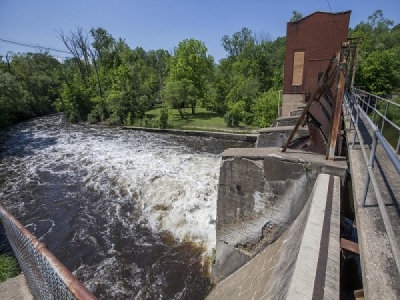
Posted on December 20, 2018
Estimated costs for a plan described as not quite the Chevy of dam removal projects could still cost the city millions of dollars.
Now the city is floating the idea of paying for removing the old Pucker Street dam on the Dowagiac River north of town with several million dollars in bonds.
City Council approved this week a resolution to issue a notice of intent to seek capital improvement bonds not to exceed 20 years and the approximate total project cost of $7 million.
But only about $4 million in bonds might be needed, because of grants and other money that can be applied to the cost.
If the bond amount stays around the $4 million mark, payments likely could be covered with money collected under an existing electrical rate surcharge, meaning an increase on ratepayers wouldn’t be needed to pay for the bonds, according to City Administrator Ric Huff.
But council member John DiCostanzo, in a meeting last week about the dam removal, wondered how costs have surged from a couple of million five years ago when planning started to around $7 million today.
If you compared the project with a style of car, DiCostanzo wondered, would it be more like a Mercedes, a Cadillac or a Yugo?
Utilities manager Jeff Dunlap said the project has been downsized twice and at this point is “below” a Chevrolet.
The removal project could soon receive permits and work possibly could start next year.
The electric dam, which is 90 years old, hasn’t been used in more than 20 years because it’s cheaper for the city to buy electricity wholesale, Dunlap has said. The dam receives some upkeep and inspections, and is deemed stable, but the state has advised the city to remove it because of structural defects that create the potential for failure.
Dunlap said estimated construction costs have risen considerably over time, from about $1 million to almost $5 million.
Consultants who have been working with the city on the project said partial sediment removal accounts for between $1.5 million and $2 million of the estimated cost, and is important to regulators in order to protect fishing areas downstream from being swamped with dirt.
They talked about the restoration of the river to what it was like before dredging and straightening that dates back to the 1800s.
While some fishermen have complained about losing a prime fishing spot at the dam, others favor the idea of removing the structure and putting the river back to what it once was, according to Marcy Hamilton, a planner with the Southwest Michigan Planning Commission, who has secured grant money for the project.
She said the work will tie into work elsewhere to restore the river’s curves.
DiCostanzo expressed frustration over the cost of removing the dam and restoring the river in order only to remove a liability.
But council members Gretchen Bertschy and Daniel VandenHeede said guarding against a potential failure was important.
“You can’t kick the can down the road forever,” VandenHeede said.
Dunlap said issuing a notice of intent doesn’t commit the council to pursuing the bond but does open a window of time in which the public could seek a referendum on the issue.
Source: South Bend Tribune





